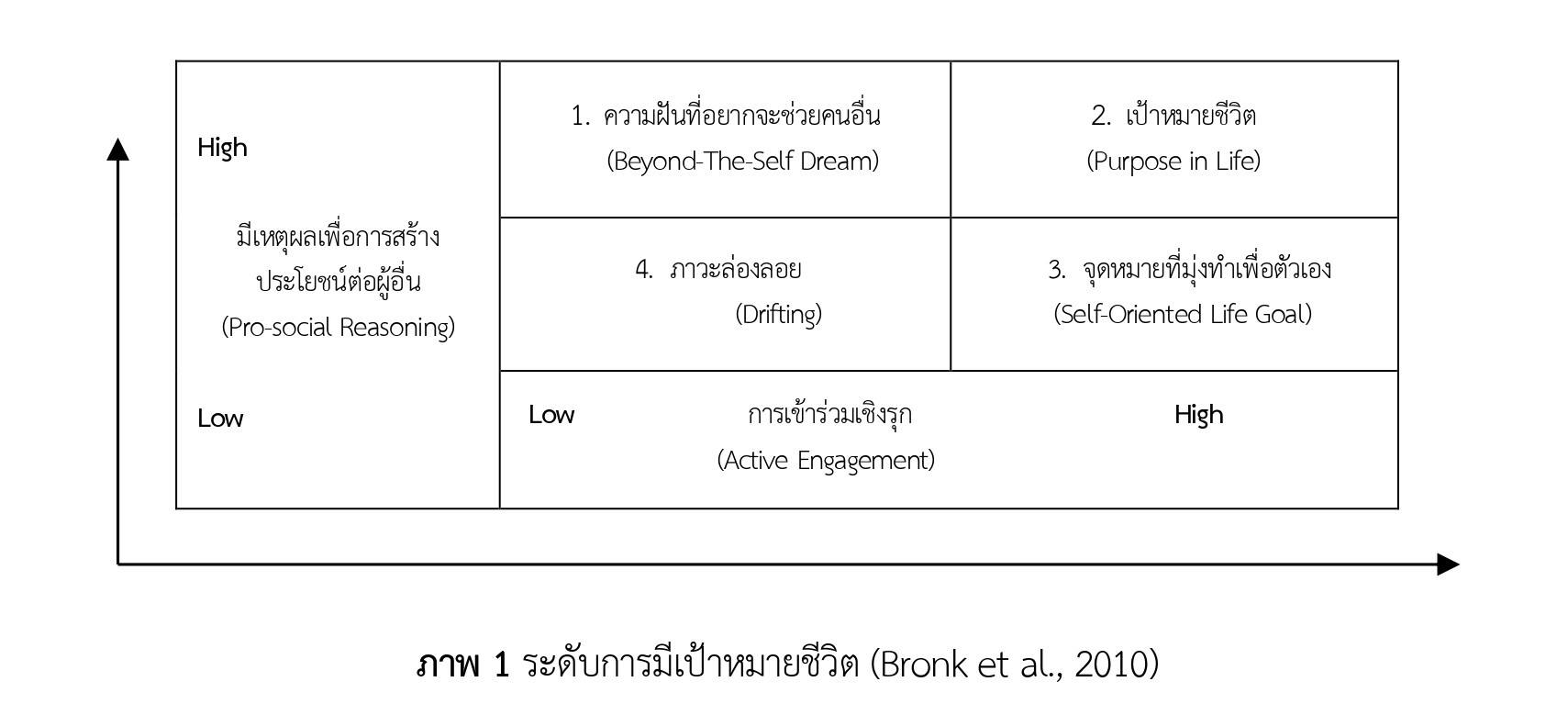Enhancing Purposes in Life for Youth Development
DOI:
https://doi.org/10.14456/psruhss.2024.1Keywords:
Purposes in life, Youth development, Thai youthAbstract
Purpose in life is an intention that leads one's life direction, based on personal beliefs, values, and needs. It affects one's decisions and actions, leading to self-development to benefit both oneself and others, and giving a sense of personal meaningfulness. Therefore, purpose in life is an important issue of positive youth development and is also in accord with the new paradigm of education, which its goals are not only to improve students' knowledge and skills but also to enhance intrinsic values and motivation for lifelong learning. The purpose of this paper is to present knowledge about purposes in life from international and domestic literature reviews promoting further studies. The topics of this paper include 1) history of the purpose in life concept 2) meaning of purpose in life 3) components of purpose in life 4) purpose in life measurements and 5) guidelines enhancing purpose in life of youth in 6 steps; preparing, relationship building, self-inquiry and learning new concepts, learning plan with goal connected to purpose, action, and reflection. The guidelines can be applied and implemented for youth development in each context to empower youth to live their lives and to foster skills for learning what they feel interested in.
References
กาญจน์สุนภัส บาลทิพย์, อุษณีย์ เพชรรัชตะชาติ, ศิริวรรณ พิริยคุณธร, สิริลักษณ์ จันเทร์มะ, และกิตติกร นิลมานัต. (2561). การพัฒนารูปแบบการสร้างเสริมสุขภาพองค์รวมของวัยรุ่นที่ติดเชื้อเอชไอวีด้วยแนวคิดเป้าหมายชีวิต. วารสารพยาบาลสงขลานครินทร์, 38(4), 49-67.
ขวัญตา บาลทิพย์, และสิริลักษณ์ จันเทร์มะ. (2556). กระบวนการสร้างเป้าหมายในชีวิตของเยาวชนที่มีชีวิตอยู่กับเอชไอวี. วารสารพยาบาลสงขลานครินทร์, 33(3), 1-13.
เทิดศักดิ์ ผลจันทร์, และไพฑูรย์ ช่วงฉ่ำ. (2561). ความหมายในชีวิตและการแสวงหาความหมายในชีวิตของนิสิตแพทย์ ชั้นปีที่ 3 มหาวิทยาลัยนเรศวร. ธรรมศาสตร์เวชสาร, 18(4), 636-643.
พระพรหมคุณาภรณ์ (ป.อ.ปยุตฺโต). (2552). พุทธธรรมฉบับปรับปรุงและขยายความ (พิมพ์ครั้งที่ 11). กรุงเทพฯ: โรงพิมพ์มหาจุฬาลงกรณ์ราชวิทยาลัย.
พิมพ์พนิต ภาศรี, กาญจน์สุนภัส บาลทิพย์, อังศุมา อภิชาโต, และอาภรณ์ทิพย์ บัวเพ็ชร. (2564). เป้าหมายชีวิตของนักเรียนในภาคใต้. วารสารพยาบาลสงขลานครินทร์, 41(1), 104-114.
สำนักงานคณะกรรมการพัฒนาการเศรษฐกิจและสังคมแห่งชาติ. (2562). ยุทธศาสตร์ชาติ พ.ศ. 2561-2580 (พิมพ์ครั้งที่ 2). กรุงเทพฯ: สำนักงานเลขานุการของคณะกรรมการยุทธศาสตร์ชาติ สำนักงานคณะกรรมการพัฒนาการเศรษฐกิจและสังคมแห่งชาติ.
อรัญญา ตุ้ยคัมภีร์. (2557). เป้าหมายในชีวิตของคุณคืออะไร. สืบค้น 15 ธันวาคม 2564, จาก https://techsauce.co/connext/get-a-job/how-to-answer-the-interview-questions-about-ambition.
อริสา สุมามาลย์. (2563). การพัฒนากระบวนการจัดการศึกษานอกระบบโรงเรียนบนฐานแนวคิดจิตตปัญญาศึกษาเพื่อเสริมสร้างเป้าหมายในชีวิตสําหรับนักศึกษาระดับปริญญาตรี (วิทยานิพนธ์ปริญญาครุศาสตรดุษฎีบัณฑิต). กรุงเทพฯ: จุฬาลงกรณ์มหาวิทยาลัย.
Balthip, K., Suwanphahu, B., & Laimek, S. (2022). Development of a purpose in life scale for Thai adolescents: A mixed-method study. Kasetsart Journal of Social Sciences, 43(3), 561–568.
Benson, P. L. (2006). All kids are our kids: What communities must do to raise caring and responsible children and adolescents (2nd ed.). San Francisco, CA: Jossey Bass.
Bernard, B. (1990). Youth Service: From Youth as Problems to Youth as Resources. Illinois Prevention Forum, 10(2), 12-27.
Bronk, K. C. (2012). A Grounded Theory of the Development of Noble Youth Purpose. Journal of Adolescent Research, 27(1), 78-109.
Bronk, K. C. (2016). Purpose in life: A critical component of optimal youth development. Place of publication not identified: SPRINGER. doi:10.1007/978-94-007-7491-9.
Bronk, K. C., Finch, W. H., & Talib, T. L. (2010). Purpose in life among high ability adolescents. High Ability Studies, 21(2), 133-145.
Bundick, M. J., Yeager, D. S., King, P. E., & Damon, W. (2009). Thriving across the life span. In W.F. Overton & R.M. Lerner (Eds.), Handbook of lifespan human development. New York, NY: Wiley.
Covey, S. R. (1989). The 7 Habits of Highly Effective People. New York: Simon & Schuster.
Crumbaugh, J. C., & Maholick, L. T. (1964). An experimental study in existentialism: The psychometric approach to Frankl's concept of noogenic neurosis. Journal of clinical psychology, 20(2), 200-207.
Damon, W. (2009). The why question: Teachers can instill a sense of purpose. Education Next, 9(3), 84-85.
Damon, W., Menon, J., & Bronk, K. C. (2003). The development of purpose during adolescence. Applied Developmental Science, 7(3), 119-128.
Drageset, J., Haugan, G. & Tranvåg, O. (2017). Crucial aspects promoting meaning and purpose in life: perceptions of nursing home residents. BMC Geriatrics, 17, 254.
French, S., & Joseph, S. (1999). Religiosity and its association with happiness, purpose in life, and self-actualization. Mental Health, Religion, and Culture, 2, 117-120.
Hill, P. L., Burrow, A. L., O’Dell, A. C., & Thornton, M. A. (2010). Classifying adolescents’ conceptions of purpose in life. The Journal of Positive Psychology, 5(6), 466-473.
Jonsen, E., Fagerström, L., Lundman, B., Nygren, B., Vähäkangas, M., & Strandberg, G. (2010). Psychometric properties of the Swedish version of the Purpose in Life scale. Scandinavian Journal of Caring Sciences, 24(1), 41-48.
Keyes, C. L., Shmotkin, D., & Ryff, C. D. (2002). Optimizing well-being: the empirical encounter of two traditions. Journal of personality and social psychology, 82(6), 1007-1022.
Knowles, M. S. (1975). Self-directed learning: A guide for learners and teachers. Chicago: Follett Publishing Company.
McKnight, P. E., & Kashdan, T. B. (2009). Purpose in life as a system that creates and sustains health and well-being: An integrative, testable theory. Review of general Psychology, 13(3), 242-251.
Okado, T. (1998). The Japanese version of the purpose in life test. Tokyo: System Publica.
Prabhat, S. (2010). Difference Between Purpose and Goal. Difference Between Similar Terms and Objects. Retrieved 15 December 2021, from http://www.differencebetween.net/miscellaneous/ difference-between-purpose-and-goal/
Schluckebier, M. E. (2013). Dreams worth pursuing: How college students develop and articulate their purpose in life (Doctoral dissertation). Iowa: University of Iowa.
Seligman, M. E. P. (2002). Authentic happiness: Using the new positive psychology to realize your potential for lasting fulfillment. New York, NY: Free Press.
Shek, D. T. L. (1993). The Chinese purpose-in-life test and psychological well-being in Chinese college students. International Forum for Logotherapy, 16, 35-42.
Shin, J. Y. (2013). Improving first-year intervention strategies at universities by focusing on meaning and purpose in life (Doctoral dissertation). Colorado: Colorado State University.

Downloads
Published
How to Cite
Issue
Section
License
Copyright (c) 2024 Humanities and Social Sciences Journal of Pibulsongkram Rajabhat University

This work is licensed under a Creative Commons Attribution-NonCommercial-NoDerivatives 4.0 International License.
Any articles or comments appearing in the Journal of Humanities and Social Sciences, Rajabhat Phibulsongkram University, are the intellectual property of the authors, and do not necessarily reflect the views of the editorial board. Published articles are copyrighted by the Journal of Humanities and Social Sciences, Rajabhat Phibulsongkram University.








